Advanced fastback design by Tokujiro Kaneko
Shinichi Kobayashi
―― About Mizushima Works
The Colt 800 was a passenger car manufactured at Shin Mitsubishi Heavy Industries’ Mizushima Works (Kurashiki City, Okayama Prefecture). At the time, Shin Mitsubishi Heavy Industries’ automobile business was conducted separately by the Nagoya Works and the Mizushima Works, and the reason for this was that each was primarily engaged in the separate development and manufacture of military aircraft during the war. The munitions factories were to be dispersed to prepare for attacks. After the war, since aircraft manufacturing was banned by GHQ, both works focused on the automobile business, with Mizushima producing three-wheeled trucks and other light vehicles such as the Minica.
―― Tokujiro Kaneko, commissioned designer
The development of Mizushima Works’ first full-fledged passenger car, the Colt 800, began in 1963, exactly when I joined the company. The design team was led by Tokujiro Kaneko, a.k.a. Toku-san, who was commissioned to lead the team, along with Masaru Okano, who had joined the company a year earlier, myself, and three others from the Nagoya Works’ design section. Toku-san was 51 years old at the time. He was an industrial designer who had graduated from Tokyo National University of Fine Arts and Music, worked at a Crafts Training Center in Sendai, and was a freelance designer invited to Mitsubishi. He had already designed the 3-wheeler Mizushima TM15, Leo, Jupiter, Mitsubishi 360, the 1st gen. Minica, and Jupiter Junior. Around this time, Fuji Heavy Industries’ Subaru 360 and Mazda’s R360 coupe were also designed by freelance industrial designers. Mitsubishi was in the same situation, with no established in-house design function yet, and we were assigned to the Vehicle Engineering Section of the Engineering Department.
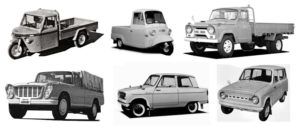
Mizushima TM15, Leo, Jupiter, Mitsubishi 360, Minica, Jupiter Junior (Clockwise from top left)
―― Lessons from Toku-san
Soon after I joined the company, a design office was set up, which was an old wooden warehouse. Toku-san basically managed all the design work for the Colt 800, and we younger designers worked as his hands and feet, drawing technical drawings for the model. The modeling staff was gathered from the manufacturing and prototype departments, with support members from Nagoya, who had experience in clay modeling from the U.S. with the Debonair and the Colt 1000. The clay model was made with their advice. Toku-san was also our educator and enthusiastically taught us the way of thinking and approach when designing. The basics of design that he taught us at that time were as follows, and they are still firmly in my memory because he repeated them over and over again.
・Today’s standard is tomorrow’s non-standard; think one step ahead without being bound by the status quo.
・Observe the shapes, colors, ecology, and mechanisms of nature.
・Challenge yourself to broaden your horizons in work and play.
Toku-san was a free-spirited and truly vital person. His way of life was dynamic. Before the war, he went to the U.S. at the age of 16 to study, and during the war, he was involved in a variety of jobs from furniture to military aircraft at the Crafts Training Center. His grandfather, whom he admired, went to the U.S. at the age of 19 and made a fortune during the gold rush. Away from work, he shared stories of things we didn’t know based on his rich life experiences at drinking parties and barbecue parties. Toku-san was also a leader in our lives as a senior.
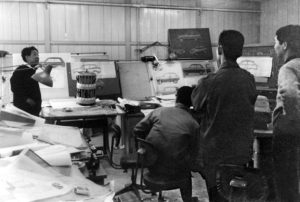
Kaneko lecturing to staff
―― Distinctive design
Unfortunately, I have little memory of the difficulty Toku-san went through with the design of the Colt 800. Since I had just joined the company, I think I was just too occupied with following his instructions and doing my own work. However, the finished design was innovative, sporty, and very exciting to me at the time.
The most distinctive feature of the Colt 800 design was its fastback. At that time, the mainstream passenger car market was dominated by notchback sedans such as the Mercedes-Benz, and there were few fastback passenger cars, which included the Citroen DS and the Saab 96, but none of them were designed to make efficient use of rear space. On the other hand, there were examples of lower profile sports-type cars that adopted the fastback design for their superior aerodynamics.

Citroen DS Photo courtesy of Motor Fan / CARSTYLING

Early scale model
The second feature was the outer flange structure. This had the advantage of facilitating spot welding body panels and at the same time facilitating press forming of the panels. The Colt 800 had an external flange from the front fenders through the roof to the rear pillars, which was unique in the industry. Another fastback-style car that partially adopted this same external flange construction was the Renault 16, which was launched nine months before the Colt 800. We had no way of knowing this at the time we were developing the car. I learned a lot from Toku-san’s use of this treatment in consideration of productivity.
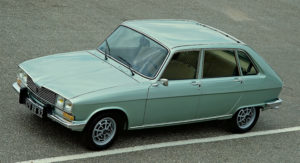
Renault 16 Photo courtesy of Motor Fan / CARSTYLING
The third feature was the use of curved glass in the doors. This was the first for a Japanese car and was also adopted in the Suzuki Fronte 800 at about the same time. The curved glass was rounded in the same way as the body, giving a sense of unity to the entire car body and greatly improving the design. Not only Mitsubishi, but all cars after this adopted the curved glass. The development of curved glass itself was the result of the efforts of glass manufacturers such as Asahi Glass (now AGC), but it can be said that Toku-san’s pioneering thinking was here.

FRP model in early design
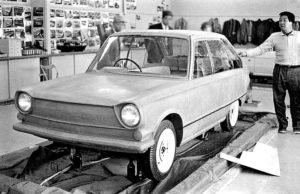
Final design clay model with acrylic windows
―― Attract attention but fail to sell well
The Colt 800 went on sale in November 1965. Its advanced styling attracted a great deal of attention from the media and other sources. We felt a great sense of accomplishment in having created a passenger car by ourselves. However, sales of the Colt 800 did not match the success of the Mazda Familia, and it was overshadowed by the explosive success of the Nissan Sunny and Toyota Corolla, and failed to ride the wave of the so-called “My Car Boom”.
I test-drove a Colt 800 after its launch and thought it was a great car, with perfect acceleration and driving performance. However, it did not have a good reputation in the market due to the high-pitched exhaust noise and white smoke characteristic of two-stroke engines. At that time, Mizushima works was focusing exclusively on research and development of inexpensive, lightweight, and powerful two-stroke engines, but the trend was shifting little by little to quieter, more fuel-efficient four-stroke engines.

―― Prop up with hatchback
Based on the market response, two years after its launch, as the Colt 1000F, the engine was changed to the Colt 1000 four-stroke engine, and in addition to the previous trunk version, the hatchback model was added to prop up the market. This hatchback was inspired by the success of the Renault 16 in Europe. We thought that the time must come for hatchbacks, and together with our engineers, we planned a hatchback model. We used a used Colt 800 prototype and worked on sheet metal and FRP work, converted the trunk into the rear gate, and got the executives’ approval. Japan’s first hatchback was the Toyopet Corona 5-door, an additional variation of the third-generation Corona, but neither was appreciated in the market. Hatchbacks were not fully accepted in mass-market cars until the 1970s when the Minica ‘7 0 and the 1st gen. Civic were at the forefront of this trend. In the 1960s, when motorization was just beginning, passenger cars had to be notchback sedans.
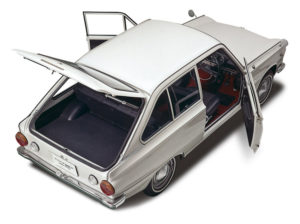 ―― In closing
―― In closing
In retrospect, I would say that the appearance of the Colt 800 I found exciting at the time was a bit oddly designed. When I look back, I regret the fact that we were just a few steps behind in so many things and that we were not good enough. Still, I think it was wonderful that Tokujiro Kaneko was so ambitious in creating a new fastback design as Mizushima works’ first full-fledged passenger car. The way of thinking about design that he taught us young designers became a source of strength, and they have been applied to our work ever since. Later, in 1970, Mitsubishi’s passenger car development division was concentrated in Okazaki City, Aichi Prefecture, but I will never forget the time when designers, modelers, and engineers got together in Mizushima and worked together enthusiastically. At that time, everyone forgot to eat and sleep, and we worked feverishly. I think this was because we strongly shared the joy of creating products.
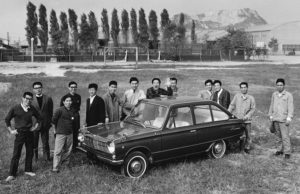
Colt 800 with design team, Kaneko in center
Edited by the editor, based on Kobayashi’s talk, with the help of former colleagues Makoto Okawa and Nobutaka Imada.
January 2022